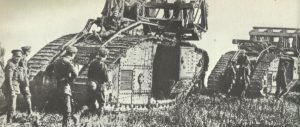The monthly days of 1917:
- January 1917
- February 1917
- March 1917
- April 1917
- May 1917
- June 1917
- July 1917
- August 1917
- September 1917
- October 1917
- November 1917
- December 1917
The situation at the fronts in 1917:

During this ‘Year of Agony’, that in so many ways began the modern world as we know it, Russia discarded absolute monarchy, underwent two revolutions and submitted meekly to an Austro-German ‘peace’ Diktat. Britain’s Army was bled white in Flanders and U-boats slaughtered her merchant sailors; the French Army was rent by mutiny and defeatism; Germany suffered increasingly severe shortages, sparking off food riots and acts of disobedience in the blockaded fleet; Austria experienced near-famine and serious unrest among her subject nationalities; worst of all Italy sustained a near-fatal blow in the field. In East Africa, Germany’s last colony was lost but the indefatigable Lettow-Vorbeck took his surviving troops into Portuguese Mozambique, prolonging this side-show by a year.
The war had become’ an ever-widening all-consuming siege of peoples in which fighting fronts and home fronts were merged in a single, indivisible ordeal’. The Allies made contradictory promises of independence to Arabs and Jews as Turkey lost Baghdad and Jerusalem to ably-commanded British armies. ‘Its only independent event, so to speak still prompted by free will and not by necessity, and ultimately its outstanding and decisive event, was America’s declaration of war on Germany.’
The severe attrition experienced during the Battle of the Somme, had induced the German High Command to abandon their advanced positions in France and withdraw to a strong fortified line which they could hold with limited forces while giving Russia a knock-out blow. This ‘Hindenburg’ (or ‘Siegfried’) Line was constructed during the winter of 1916-17. More accurately, the ‘Line’ was a complex zone of trenches, concrete shelters, gun emplacements, and barbed (or ‘razor’) wire. It was extended even farther to the rear by the ‘Hunding’ and ‘Brunhilde’ lines completed in 1918. Germany’s propagandists and apologists trumpeted the ‘impregnable’ character
of the Line during 1917-18 to counteract the growing war weariness of their undernourished people. Ludendorff ventured the opinion that the Line could be held until the unrestricted U-boat campaign had brought the English to their senses (and their knees!).
Early in 1917 German forces withdrew to the Hindenburg Line, carrying out ruthless deportations and demolitions as they did so. Army Group Commander Prince Rupprecht protested against this unnecessary and self-defeating savagery and threatened to resign. Allied offensives in April freed Vimy Ridge, but appalling French losses during the excessively promoted and inept Nivelle Offensive on the Aisne sector sparked off large-scale mutinies. Thanks to the masterly intervention of Petain, these outbreaks were quickly and secretly suppressed.
In June, the British, under Plumer seized the Messines Ridge and other key points in the Ypres Salient. But pro longed attempts from 31 July to advance eastward from Ypres towards the U-boat bases on the Flanders coast (Third Battle of Ypres or Battle of Passchendaele) achieved very little at appalling cost. Many hundreds (if not thousands) of British and Empire soldiers simply disappeared, drowned in the bottomless mud. Perhaps the British offensive did (as Haig and Robertson claimed) hold German attention at a critical period while the battered French Army staged a slow recovery. But surely similar results could have been achieved with superior strategy (for example, detailed plans existed for an amphibious assault on the German-occupied Belgian coast, utilizing special landing craft and tanks) at far less cost in human life.
During August-October, the French made significant gains before Verdun and took the Chemins des Dames Ridge in well-planned and executed limited attacks.
The Italians had continued their repeated offensives against the Austrian line along the Isonzo River north-east of Venice. Small gains had resulted and the Italian line be come overextended. Repeated appeals for the despatch of Anglo-French heavy guns had elicited a meager response. Italian C-in-C Cadorna had suspected an impending Austro-German offensive but his precautionary measures had not been implemented by dilatory corps commanders. The Italian gas masks offered only limited protection, and Italian airmen were, in general, outclassed by German veterans from the Western Front. Unbeknown to the defenders, a crack German expeditionary force of seven divisions had been railed secretly from the moribund Eastern Front. Its junior leaders – all converts to the novel ‘storm troop’ infiltration tactics associated with General Hutier – included a certain infantry officer from Wurttemberg, Erwin Rommel.
On 24 October 1917 the blow fell at Caporetto. The Italian line collapsed and was pushed back 70 miles (ca. 113 km) to the Piave river with the loss of 320,000 men and 3000 guns. Eleven divisions of British and French reinforcements were rushed to the Piave and a ‘Supreme War Council’ was established to secure a unified strategy. At this dark hour, a ray of hope was provided by the surprise attack of massed British tanks at Cambrai (20 November). True, the breakthrough was short-lived and soon eliminated by German reinforcements railed from the Eastern Front and from Italy, but the potential of massed armor had been proved beyond a doubt. It was, according to the Daily Mail correspondent, H W Wilson, ‘the vindication of mechanical war’.




